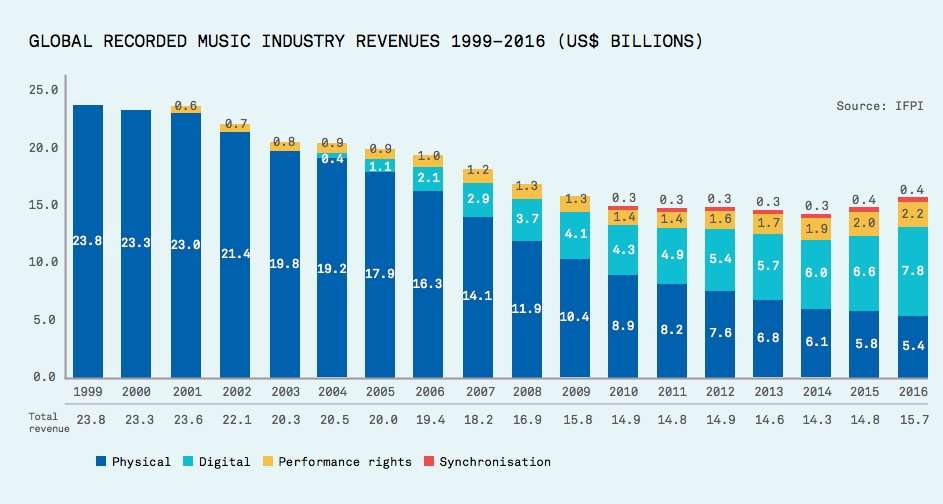One might guess that they earned most of it during the 1990s. Wrong. Even if we limit the observation to the 2000-2010 decade only, the list did not change much. It means the late comers like Beyonce, or Taylor Swift might earn big for a given year, and probably for years to come. But the old cracks are just not ready to retire.
On the other hand, the list missed the likes of Michael Jackson, whose last tour was in 1997 before he wrangled with law suits and health problems. Had the lists started five years earlier, he should have been there. Similarly, Guns N' Roses had long been absent due to break up and shake up. They did play under new line-ups during the 2000s, which were not enough to make them entering the list. But last year, their reunion made them second top earner behind Beyonce.
Some detailed observation on the list provide interesting variations. The top two, The Stones are U2, are quite alike; they played almost similar number of concerts, with almost similar audience and revenue per show. Bruce "The Boss" Springsteen, like Elton John, played in more but smaller concerts in terms of audience.
Only two artists - both are ladies - earned more than $100 per concert (sorry Roger Waters, you're just 3 cents short). Madonna, who performed less but earned more per concert. Celine Dion, who was the opposite, played in three times more concerts as Madonna, but the average audience was only a fifth.
Top 25 artists who earned the most from live shows, 1990-2014
| No. | Artist | Gross revenue | Attendance | No. shows | Average revenue | Average attendance |
| 1 | The Rolling Stones | $1,565,792,382 | 19,677,569 | 538 | $79.57 | 36,575.4 |
| 2 | U2 | $1,514,979,793 | 20,536,168 | 526 | $73.77 | 39,042.1 |
| 3 | Bruce Springsteen | $1,196,116,507 | 15,010,773 | 727 | $79.68 | 20,647.6 |
| 4 | Madonna | $1,140,230,941 | 9,694,079 | 382 | $117.62 | 25,377.2 |
| 5 | Bon Jovi | $1,030,082,884 | 12,333,668 | 578 | $83.52 | 21,338.5 |
| 6 | Elton John | $786,791,043 | 12,164,513 | 956 | $64.68 | 12,724.4 |
| 7 | Dave Matthews Band | $776,969,736 | 17,823,077 | 992 | $43.59 | 17,966.8 |
| 8 | Celine Dion | $737,573,927 | 6,546,109 | 1,143 | $112.67 | 5,727.1 |
| 9 | Kenny Chesney | $752,706,599 | 12,681,629 | 755 | $59.35 | 16,796.9 |
| 10 | The Eagles | $702,110,908 | 7,720,760 | 484 | $90.94 | 15,952.0 |
| 11 | The Police/Sting | $556,114,962 | 7,257,611 | 605 | $76.63 | 11,996.1 |
| 12 | Roger Waters | $547,305,412 | 5,474,759 | 316 | $99.97 | 17,325.2 |
| 13 | Paul McCartney | $505,534,809 | 5,248,175 | 220 | $96.33 | 23,855.3 |
| 14 | Billy Joel | $499,978,726 | 10,408,169 | 577 | $48.04 | 18,038.4 |
| 15 | Rod Stewart | $497,033,399 | 7,885,676 | 714 | $63.03 | 11,044.4 |
| 16 | Neil Diamond | $465,448,371 | 8,870,666 | 643 | $52.47 | 13,795.7 |
| 17 | Metallica | $432,816,245 | 8,388,374 | 468 | $51.60 | 17,923.9 |
| 18 | Aerosmith | $417,573,638 | 8,405,069 | 582 | $49.68 | 14,441.7 |
| 19 | George Strait | $405,034,063 | 9,736,580 | 584 | $41.60 | 16,672.2 |
| 20 | Jimmy Buffett | $402,756,057 | 9,746,471 | 539 | $41.32 | 18,082.5 |
| 21 | Coldplay | $378,359,252 | 5,394,616 | 315 | $70.14 | 17,125.8 |
| 22 | Toby Keith | $361,256,245 | 8,608,696 | 711 | $41.96 | 12,107.9 |
| 23 | Cher | $351,625,611 | 4,531,739 | 548 | $77.59 | 8,269.6 |
| 24 | Fleetwood Mac/Stevie Nicks | $349,906,931 | 4,906,995 | 483 | $71.31 | 10,159.4 |
| 25 | AC/DC | $337,879,092 | 5,387,353 | 316 | $62.72 | 17,048.6 |
So why do those old artists still actively touring? Hard to single out one reason. But given the big money involved in the live music industry, who could refuse a piece of the cake? Even just to make a one-time bang like Led Zeppelin, or a last goodbye like Motley Crue.
For some, like U2 or The Boss, they are still in the job market, producing new records. So perhaps for them, 2010s is just the new 1980s.
Other motives are hard to quantify, like connecting to fans, nostalgia, or else. But for The Stones, the youngest of them, Ronnie Wood is 70, the reason for hanging around should be a simple one: because they can.
